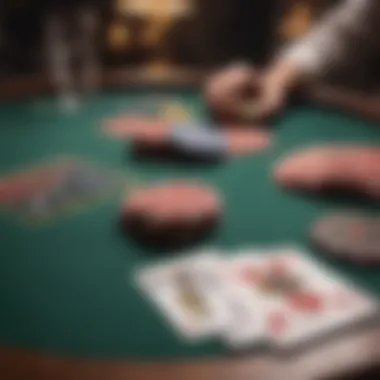Mastering Three Card Poker: Key Strategies and Insights


Intro
Three Card Poker presents a unique blend of strategy and chance, capturing the attention of players across the globe. Unlike traditional poker games that require extensive card play, this game distills the essence of poker into a simpler format, making it appealing not just to seasoned players but also to novices just dipping their toes into the world of gambling.
While many casino games revolve solely around luck, Three Card Poker invites a layer of strategic finesse, enabling players to make knowledgeable decisions that can significantly influence their outcomes. It's an engaging experience that combines swift gameplay with an underlying complexity that requires focus and understanding.
As we explore this captivating game, we’ll dissect its mechanics and delve into the psychological dynamics that come into play. Let’s unpack the intricacies that make Three Card Poker a distinctive addition to the poker genre and the casino landscape at large.
Prolusion to Three Card Poker
Three Card Poker has emerged as a significant player in the realm of casino gaming since its inception. Although relatively new compared to its poker counterparts, it offers both thrill and accessibility, attracting a wide range of participants from novices to seasoned gamblers alike. This section highlights the manifold reasons for delving into Three Card Poker, illuminating its intricate dynamics and foundational role within the broader poker landscape.
The Origins of the Game
Three Card Poker traces its roots back to the late 20th century, specifically designed by Derek Webb in 1994. Unlike the traditional versions of poker, which require considerable experience and strategic depth, this variant was formulated to provide a fast-paced gaming experience that emphasizes simplicity. Webb's innovation was not just the rules but the very idea of rapid gameplay paired with a pragmatic approach to poker betting. By mixing classic poker hands with a betting structure that tantalizes the players’ competitive spirits, it crafted a versatile avenue for players.
In the years that followed, the game made its way into casinos primarily across North America. Its straightforward structure and quick rounds resonated well with players who perhaps found Texas Hold'em too intense or time-consuming. Introduced as an alternative inside poker rooms and gaming floors, its popularity snowballed. It also transitioned seamlessly into online platforms, heightening its reach and appeal.
Three Card Poker in Modern Casinos
Today, Three Card Poker holds a unique position in both land-based and online casinos. Its tables are often bustling, showcasing the game’s allure. The rules are easy to grasp, which allows newcomers to join in without feeling overwhelmed, while still providing enough depth for seasoned players to apply strategic insights.
- The combination of ante betting and player-versus-dealer mechanics enhances the competitive edge.
- Pair Plus bets introduce an additional layer that offers payouts for strong hands regardless of whether one wins the main bet.
Fueled by the gambling industry's evolution, casinos are constantly innovating how they present and market games. Three Card Poker has benefitted from this trend by being included in major casino promotions and tournaments, thus embedding itself firmly within gaming culture.
"Three Card Poker isn’t just a game. It's a community where players bond over strategy and luck, making it a lively extension of poker culture."
Its accessibility, thrilling mechanics and rapid pace make Three Card Poker worthy of any gambler's attention. As we move deeper into this exploration, understanding what makes this game tick will unveil both its current standing and future potential in the gaming world.
Game Mechanics and Rules
The game mechanics and rules of Three Card Poker serve as the backbone of the game, laying the groundwork for both play strategy and player experience. Understanding these elements is crucial for engaging with the game at any level, from novice players finding their footing to seasoned gamblers honing their strategies. The simplicity of rules, combined with strategic depth, makes it a compelling choice in casinos. Not to mention, the faster pace compared to other poker variants appeals to players seeking quick action and excitement.
Basic Tenets of Three Card Poker
To grasp Three Card Poker, one must first acknowledge its fundamental principles. The game utilizes a standard deck of 52 cards and involves players competing against the dealer rather than each other. Each player receives three cards, and the objective is to beat the dealer’s hand based on poker rankings, though with a twist. This variant dismisses the element of community cards, driving players to rely solely on their hands.
In addition, Three Card Poker presents differing player decisions depending on the cards dealt. With just three cards, players must calculate their chances and make swift decisions. This contributes to the rush of adrenaline at the table, as quick judgment often means the difference between wins and losses.
Understanding the Betting Structure
The betting structure is a cornerstone of Three Card Poker, introducing various angles for players to explore their game strategy. It’s also where a player can really feel the thrill of potential gains or the sting of losses.
Ante Bet
The Ante Bet is the foundational stake in the game, required at the start of each round. This initial wager is necessary for participation and sets the stage for subsequent decisions. The key characteristic of the Ante Bet is its straightforwardness; players simply place their bets without needing to analyze a complicated payout structure. While this simplicity makes it an attractive choice for novices, it demands a certain level of discipline. A unique feature of the Ante Bet is that it's the only bet players can make before seeing their cards. This opens the door to a blend of luck and gamble, making it vital in the overall strategy.
Pair Plus Bet
On the flip side, the Pair Plus Bet offers a more exciting variation to the standard betting structure. This optional wager allows players to bet on whether their three cards alone will form a pair or better. Its appealing nature lies in the potential for larger payouts, regardless of the dealer’s hand, which can be tempting. Unlike the Ante Bet, the Pair Plus Bet pulls players into an additional layer of risk, as they can win without even beating the dealer. However, as enticing as the payouts may seem, the odds of hitting a strong hand are lower, making this an option worth considering with caution.
Play Bet
Lastly, the Play Bet comes into play once players have seen their hands. After a player places the Ante Bet and receives their three cards, they must decide whether to raise their bet or fold. The Play Bet serves as the raise and is equal to the Ante Bet. This aspect keeps players on their toes; the decision to go all in hinges on their initial cards and the dealer's hole card. The unique feature here is its tension-building nature, forcing players to engage actively with their hands. It encourages strategic thinking, as the potential upside is contingent upon the strength of the player's hand interacting with the dealer's.
Winning Combinations


Winning in Three Card Poker necessitates a solid understanding of the combinations players aim for. Familiarity with these combinations not only sharpens strategy but also helps in placing bets with confidence.
High Card
At the bottom of the hierarchy, a High Card hand represents a situation where players can’t form any decent combinations. While it may seem lackluster, its importance in the hierarchy cannot be overlooked, especially when determining the winner against the dealer. It serves as a reminder that every detail counts in the game. Despite being the most basic outcome, players can find themselves in intense action when that high card tips the scale.
Flush
Moving up the ladder is the Flush—a combination where all three cards are of the same suit. This hand can swing the advantage in favor of the player, offering a strategic elevation in play. The Flush can catch players off guard, turning a seemingly average hand into a moment of triumph. Gamblers often feel a surge of excitement as they assemble their suited cards.
Straight
The Straight, consisting of three sequential cards, adds another layer of intrigue. This combination often flies under the radar, yet its elegance lies in its simplicity. Players might be drawn to collecting cards that fit this category, but it poses a risk: you can be left hoping for that final card to complete the set. Understanding its value might shift a player's approach during play, making it crucial for strategic play.
Three of a Kind
When players hit a Three of a Kind, they know they've landed a powerful hand right off the bat. This hand has a high ranking and is a sound strategy against the dealer. Its presence can create opportunities for strong bets, ratcheting up the stakes in a meaningful way. The anticipation associated with having three of a kind can set the stage for dominant gameplay.
Straight Flush
Finally, the Straight Flush—the jackpot of three-card hands—brings everything to a head. Making a straight flush is no small feat, and its rarity makes each instance electric. True triumph comes with enormous payouts when players achieve this, solidifying its status as the ultimate hand. It’s the hand every gambler hopes for, highlighting the fun of Three Card Poker and keeping the game engaging.
Understanding these combinations not only enhances gameplay but also allows for smarter betting choices. Players who can quickly identify potential winnings elevate their experience and may dig deeper into the game's strategic depths.
Strategic Approaches
When diving into the world of Three Card Poker, understanding strategic approaches is paramount. The blend of luck and skill in this game isn’t just about hoping for a good hand; it’s about knowing how to play the cards you’re dealt effectively. This section will unravel the specific elements of strategic play, the benefits it provides, and considerations one should keep in mind to enhance their performance at the tables.
Optimal Play Strategies
The essence of succeeding in Three Card Poker lies in mastering optimal play strategies. Unlike traditional poker, where bluffing and reading opponents are crucial, Three Card Poker often pivots on what's in front of you and how you choose to react. A player must know when to grasp the opportunity and when to recede back into caution.
For beginners, sticking to basic strategies can be quite beneficial. For instance, one widely accepted guideline suggests that if a player's hand consists of a Queen-high or better, making the play bet is generally advisable. This simplifies decision-making and reduces the ambiguity that often clouds judgment during gameplay.
- Common Strategies Include:
- Playing strong hands: Always bet when you’ve got a Queen-high or better.
- Folding weak hands: Hands lower than a Queen-high, like a 9-5-3, usually don’t warrant a bet.
- Pair Plus Bet: Even if your hand isn't great, the Pair Plus option can sometimes offer better returns.
The benefit of these strategies is that they not only help limit losses but also build confidence in players, especially new entrants. Over time, one can adapt these strategies based on experience and personal comfort level with risk.
When to Bet or Fold
Knowing the right moment to place a bet or fold can be the thin line between a lucrative night or a disappointing one. Three Card Poker's rapid pace often leads players to make hasty decisions, which can be costly.
It’s crucial to assess the situation logically.
- Considerations for Betting:
- Strong Hands: Go all in when you have strong hands.
- Context: Sometimes situational awareness matters. The state of the table can influence decisions.
- Trends: If many players are folding, you might want to go for a bet, as the odds can be favorable.
Conversely, folding shouldn't be viewed as a weakness. If you've drawn subpar cards, there’s no shame in folding. Losing a small amount can be better than letting emotions drive additional losses.
In essence, establishing a rhythm of when to engage and when to hold back can significantly amplify one’s chances of success:
- Key Indicators for Folding:
- Low-Value Hands: Anything significantly lower than a Queen-high.
- Imbalance: If your hand’s potential seems unlikely compared to what’s on the table.


“In Three Card Poker, it’s not about having the best hand all the time, but knowing how and when to play the hand you’ve got.”
Ultimately, the crux of strategic approaches in Three Card Poker lies in balancing risk and reward. By understanding optimal play strategies and being judicious about when to bet or fold, players can navigate the waters of the game more effectively, making the experience not just exciting but also rewarding.
The Role of Luck and Probability
In the realm of Three Card Poker, the spotlight often shines on luck and the probabilities intertwined with each hand dealt. While seasoned players strategize their gameplay, the outcome ultimately hinges on elements beyond one’s control. This duality captivates players, drawing them into the thrilling uncertainty that accompanies every round. Luck, that elusive gremlin, plays a considerable role, as it determines the initial hand and influences the subsequent choices players make.
Understanding the Odds
When you sit down at a Three Card Poker table, it's essential to grasp the odds behind your decisions. The basic premise is simple: players aim to create the strongest three-card hand, competing against the dealer instead of each other. Understanding the different winning combinations can aid players in assessing their chances. Here’s how the odds stack up:
- High Card: The most basic hand, often leading to loss.
- Flush: A favorable result for players; these hands win against high cards significantly.
- Straight: Slightly better than a flush but still dependent on what the dealer holds.
- Three of a Kind: A player’s best friend; this hand frequently takes the pot home.
- Straight Flush: The king of hands, rare yet immensely rewarding if achieved.
The probabilities of receiving these hands significantly influence betting decisions. For instance, knowing that the likelihood of flopping a straight flush is much lower than a high card can guide the player’s strategy accordingly. Hence, players can often forecast their moves based on familiar odds.
"While skill and strategy lay the groundwork, luck often plays the ace up the sleeve in Three Card Poker."
Implications of Variance
Variance, by nature, introduces a fascinating layer to Three Card Poker. It refers to the fluctuations in outcomes you can expect over time due to the inherent randomness of the game. Simply put, variance can turn the tides in the blink of an eye. A player may experience streaks of wins followed by equally chaotic rounds of losses, leaving them often questioning their strategy.
In the short term, variance can be a cruel mistress, often leading to gut-wrenching swings that can make even the most seasoned players feel the heat. However, understanding and accepting variance is crucial. Here are some key points regarding its implications:
- Short-Term Variance: In the short haul, one can face wild swings, making it challenging to assess overall skill or strategy effectiveness.
- Long-Term Perspective: With experience, players start noticing patterns over longer spans, providing insights into their approach.
- Risk Management: A healthy understanding of variance can help players manage their bankroll effectively, avoiding all-in bets during a losing streak.
Thus, while the role of luck cannot be refuted, understanding probability and variance offers players informed insights. This knowledge enhances decision-making and enables better management of expectations. In essence, embracing the unpredictability of the game could lead players towards a more rounded understanding of Three Card Poker.
Psychological Factors in Gameplay
When it comes to Three Card Poker, understanding the psychological factors at play can often be just as crucial as mastering the rules or strategies. The nature of gambling, especially in a game that blends chance with skill, opens the door to a range of emotional responses and behavioral tendencies that players exhibit during the gameplay. These psychological elements can have a direct impact on decisions made at the table, influencing outcomes far beyond the cards themselves.
The significance of psychological factors in Three Card Poker extends to both experienced gamblers and novices. Recognizing how stress, confidence, thrill, and even frustration operate under the spotlight of casino lights can help players manage their choices effectively and enhance their overall gaming experience. Understanding one's own mental state, as well as that of others at the table, can lead to more informed and strategic play.
Behavioral Patterns of Players
Players in Three Card Poker often exhibit distinct behavioral patterns based on their emotional states and cognitive processes. For instance, a player in a winning streak may display overconfidence, leading to more aggressive betting. Conversely, a player facing losses could become overly cautious or even make erratic decisions fueled by frustration.
Some common behavioral patterns include:
- Risk Taking: When players feel invincible, they might take larger risks, often ignoring optimal strategies. This can lead to significant gains or painful losses.
- Concentration Levels: How focused a player is can change how they read the game. Distracted players might miss critical opportunities, while highly focused individuals can better analyze opponents’ behaviors.
- Social Interactions: The presence of others can alter a player's performance. Some thrive in a social setting, using banter to enhance their gameplay, while others shy away, preferring solitude.
This understanding of player behaviors can help one anticipate possible moves at the table and adjust strategies accordingly.
Managing Emotional Responses
Effective management of emotional responses during gameplay can differentiate a casual player from a strategic one. Amid the thrill of the game, emotions like euphoria, anxiety, or disappointment can cloud judgment. Here are a few ways to manage these emotional responses effectively:
- Practice Mindfulness: Staying present and aware can help mitigate strong emotional reactions. Focusing on breathing or the current hand aids in calming nerves.
- Set Limits: Before playing, set limits on both time and money to minimize pressure. A predetermined budget can reduce anxiety about losses, allowing one to play more freely.
- Take Breaks: If the stakes get too high or emotions run wild, taking a step back can provide clarity and help reset one’s mental state.
Ultimately, understanding one’s psychological makeup contributes to the enjoyment of the game while enhancing strategic decision-making. In a game as dynamic as Three Card Poker, mastering the mind is often just as vital as mastering the cards themselves.
"The mind is a battlefield; the cards are merely players on the field."
Grappling with these psychological factors can empower players to make wiser choices and enjoy this thrilling game even more.
Comparative Analysis with Other Poker Variants


Understanding Three Card Poker in a broader context can significantly enhance one's appreciation and strategy for the game. The comparative analysis with other poker variants not only clarifies what makes Three Card Poker unique but also highlights its appeal to diverse audiences. By examining the design and play style of various poker options, players can make more informed decisions and tailor their strategies to maximize their enjoyment and potential success at the table.
Three Card Poker vs. Traditional Poker
When juxtaposing Three Card Poker with traditional forms of poker, the differences become strikingly clear. Traditional poker games, like Texas Hold'em or Omaha, generally involve a deeper layer of strategy, relying on not only personal cards but also communal cards. In contrast, Three Card Poker simplifies the experience significantly. Players work with just three cards dealt to each individual, based on individual hands, which condenses the decision-making process.
In Three Card Poker, there are key elements that shift the strategy:
- Fast-Paced Gameplay: Games usually play out in a matter of minutes, which appeals to players looking for quick action.
- Simplified Betting: The betting structure is straightforward; players must decide between betting or folding based solely on their three cards, unlike the multifaceted betting strategies in traditional poker games.
- Focus on Luck: While strategy plays a role, especially in knowing when to bet or fold, luck heavily dictates outcomes since so little information is available to gauge opponents' hands.
Key Differences:
- Hand Rankings: In traditional poker, the hand rankings form an intricate hierarchy. Understanding nuances like two pairs versus a straight can often dictate strategies. In Three Card Poker, however, the hand rankings are simplified, allowing players to quickly recognize the strength of their hand.
- Level of Competition: Traditional poker often attracts seasoned strategists and professionals, which can intimidate new players. In contrast, Three Card Poker creates a more relaxed, accessible environment for gamblers of all experience levels.
- Player Interaction: In classic poker, reading opponents is crucial. Body language and betting patterns can disclose valuable information. However, Three Card Poker sits players in a more solitary position against the dealer, minimizing the necessity of social interaction in strategic play.
"In Three Card Poker, the tide of victory often turns on a single hand—strategies can help, but luck's hand prevails."
The Appeal of Poker Face Games
Poker face games such as Three Card Poker bring their own unique charm to the table. The design of these games prioritizes the anticipation and thrill accompanying the reveal of hands, engendering a captivating experience for both players and spectators.
Some elements contributing to this appeal include:
- Simplicity: Newcomers can often join in without needing to understand complex rules or strategies, making it a go-to choice for casual outings at the casino.
- Excitement of Quick Rounds: The swift nature of gameplay fuels excitement. Players can engage in multiple rounds in a short span, feeding the adrenaline rush and making it easy to stay involved for hours.
- Element of Surprise: Players relish the mystery behind flipping over three cards, leading to an environment buzzing with anticipation.
Ultimately, a player’s connection to the game can stem not only from strategic engagement but also from the sheer enjoyment of the chase. Poker face games leverage these elements to create enticing, dynamic experiences that attract a spectrum of gaming enthusiasts.
By observing these differences and attractions, players can make more educational choices in how they approach Three Card Poker, further enriching their gambling experience.
Future Trends in Three Card Poker
The landscape of poker, particularly in its more modern twists like Three Card Poker, is undergoing significant transformations. As technology and consumer preferences evolve, it becomes vital to explore how these changing tides influence the gameplay and overall popularity of the game. This section will dissect two main future trends that carry substantial weight—the rise of online platforms and innovations in gameplay.
The Rise of Online Platforms
In the last decade, online gaming has exploded in popularity, and Three Card Poker is no exception. Casinos and poker rooms have started migrating their operations to digital spaces to reach a wider audience. The reasons for this shift are numerous:
- Accessibility: Players can now enjoy the game from the comfort of their homes. No need to travel to a physical casino—just a click and a few taps, and the action is underway.
- Diverse Options: Online platforms offer various formats of the game, from low-stakes to high-stakes tables. This caters to all types of players, whether you're a rookie just trying your hand or a seasoned gambler looking to make substantial bets.
- Live Dealer Experiences: A relatively new feature is the live dealer option, where real dealers conduct the game in real-time, bringing a sense of authenticity to online play. This bridges the gap between the online and physical casino experience, making players feel they are in an actual casino, even if they're miles away.
- Bonuses and Promotions: Online casinos often roll out eye-catching bonuses, be it for new sign-ups or loyal customers. Players have a treasure trove of opportunities to maximize their bankroll, enhancing the enjoyment of gameplay.
As the digital domain continues to expand, the adoption and refinement of Three Card Poker on these platforms will likely attract more players, reshaping the game’s audience and strategy in the coming years.
Innovations in Gameplay
Innovation is the lifeblood of any game, and Three Card Poker has seen its fair share of creative advancements. Here are some innovations that could redefine how players engage with this popular variant:
- Augmented Reality (AR) and Virtual Reality (VR): These technologies are starting to make waves in the gambling world. Imagine putting on a headset and stepping into a virtual casino where you can sit at a Three Card Poker table, interact with players and dealers, and experience the game like never before. The possibilities are endless; creating an immersive experience could attract a broader demographic.
- Smartphone Applications: Many casinos are launching their own dedicated apps showcasing Three Card Poker. Features like tutorials and practice modes allow novices to get a grip before diving in, making this game accessible to an even wider audience.
- Game Variants: Some developers are exploring alternative rules or side bets which could enhance the traditional game. Mixing in varying elements might appeal to seasoned players tired of the same old format and craving fresh experiences.
- Data Analytics and AI: Advanced statistical models are starting to influence strategy. Some online platforms provide players with analytical tools that can track their performance and suggest improvements, pushing the boundaries of traditional gameplay by integrating data science into the mix.
"The evolution of gameplay strategies in Three Card Poker may hinge on technological advancements. Understanding these changes enables players to adjust effectively, ensuring longevity in their enjoyment of the game."
As these innovations unfold, they not only enhance player experience but also sustain engagement in Three Card Poker by introducing new challenges and opportunities. The marriage of technology and traditional gameplay is a recipe for a dynamic future.
Ending
The conclusion of this article holds significant weight, bringing all the preceding elements together while underscoring the multifaceted nature of Three Card Poker. This game stands at an intersection where strategy meets luck, captivating both new and seasoned players alike. The importance of understanding key insights about the game cannot be overstated, as it ensures not just participation but also enjoyment and potential success at the table.
Summarizing Key Insights
As we reflect on the intricacies of Three Card Poker, several pivotal insights come to light:
- Game Mechanics: Grasping the essential rules and betting structures is foundational. Players need a firm grasp of how to navigate the game’s betting options, including Ante and Pair Plus Bets. Without this knowledge, even the most strategic player might stumble.
- Strategic Approaches: Optimal play strategies help guide players on when to bet or fold, emphasizing the significance of calculated risks rather than mere gut feelings. This strategy can make or break a session at the tables.
- Psychological Elements: Understanding behavioral patterns can shed light on one's own gameplay. Emotions influence decisions; thus, mastering emotional responses can lead to improved performance. Managing stress and keeping a level head allows for better decision-making.
- Comparative Analysis: Examining how Three Card Poker stacks up against traditional poker games provides valuable context, heightening appreciation for its unique dynamics. In essence, this comparative perspective enriches the player's experience.
- Future Trends: With the rise of online platforms and innovations in gameplay, being aware of emerging trends puts players in a position to adapt and evolve with the game. Staying in the loop helps ensure that players remain competitive.
Final Thoughts on Three Card Poker
Three Card Poker offers a unique entry point into the world of card games that appeals to a wide audience. Its blend of simplicity and strategic depth makes it an appealing choice for many gamblers. The rules may appear straightforward at first glance, yet mastering the nuances can reveal layers of complexity that challenge the intellect.
By exploring the various aspects discussed in this article, players can harness a greater understanding, allowing them to enhance their gaming experience. In the ever-changing landscape of casino games, knowing the ropes of Three Card Poker enhances both the enjoyment and the potential for profit. Regardless of whether you play for fun or for real stakes, an informed approach amplifies the excitement.







